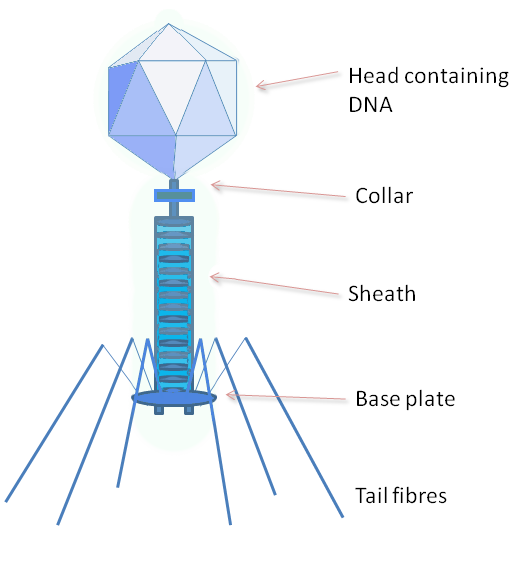A bacteriophage is a group of viruses that infect bacteria. It hijacks the bacterium’s cellular machinery to produce viral components inside it. Bacteriophage also infects single-celled prokaryotic organisms known as archaea.
Independently discovered in 1915 by Frederick W. Twort, Great Britain, and in 1917 by Félix d’Hérelle, France.
Index
History
Frederick William Twort was an English bacteriologist and was the original discoverer of bacteriophages. He studied medicine at St Thomas’s Hospital, London, and was a professor of bacteriology at the University of London.

Félix d’Hérelle was a French microbiologist. He was a co-discoverer of bacteriophages. He experimented on bacteriophages with the possibility of phage therapy. D’Herelle is credited for contributions to the field of applied microbiology.

Structure
Following are a few points on the structure of Bacteriophage:
- Phage consists of a polyhedral head.
- Phage may be enveloped or non-enveloped.
- It has different shapes, such as rod-shaped, filamentous, isometric, etc.
- The genome is linear or circular and consists of ss or ds DNA or RNA.
- The protein genome codes range from 4 to 100.
- Largest genome in a bacteriophage is 735 kbp.
- The tails may be contractile or noncontractile, long or short.
- Tail fibers help in anchoring the virus to the bacterial cell wall.

Lifecycle of a Bacteriophage
During an infection, the bacteriophage attaches itself to a bacterium and transfers its genetic material into the cell. Once after transferring of genetic material, the phage usually follows one of the two life cycles
- Lytic (virulent)
- Lysogenic (temperate).
Lytic phages overtake the machinery of the bacterial cell to make phage components and then lyse the cell. Hence, releasing new phage particles.
Lysogenic phages incorporate their nucleic acid into the chromosome of the host bacterial cell and replicate with it without destroying the bacterial cell. Under certain conditions, lysogenic phages induce into the lytic cycle.
Other life cycles include
- Pseudolysogeny and
- Chronic infection
In pseudolysogeny, the phage enters a cell but does not co-opts cell-replication machinery or integrate stably into the host genome.
Pseudolysogeny usually occurs when a host cell encounters unfavourable growth conditions. This plays a vital role in phage survival. This enables the preservation of the phage genome until host growth conditions become advantageous again.
In chronic infection, new phage particles are produced continuously for an extended period but without apparent cell killing.
Uses of Bacteriophage
Phages are used in the following:
- Phage therapy is used as an antibiotic against bacteria since they have the same mode of action.
- The food industry kills bacteria in meat and other products.
- Diagnostic purposes.
- Model in research and studies.
- As cloning vector in the field of genetic recombination technique.
Questions
1. What is the bacteriophage coat made of?
It is made up of a protein coat encapsulating the genome, known as a capsid.
2. What is Pseudolysogeny?
In pseudolysogeny, bacteriophage enters a cell but does not co-opts cell-replication machinery or integrate stably into the host genome. Pseudolysogeny occurs when a host cell encounters unfavourable growth conditions.
FAQs
A bacteriophage is a group of viruses that infect bacteria. Bacteriophage hijacks the bacterium’s cellular machinery to produce viral components inside it.
Bacteriophage is a virus that infects bacteria.
Bacteriophages can have either DNA or RNA
Although bacteriophages cannot infect and replicate in human cells, they play an essential role in medical research for humans.
Related Topics
